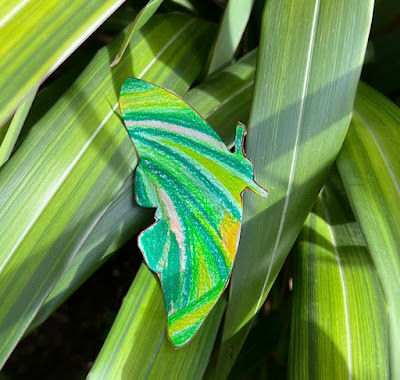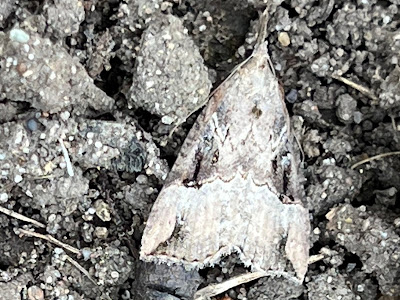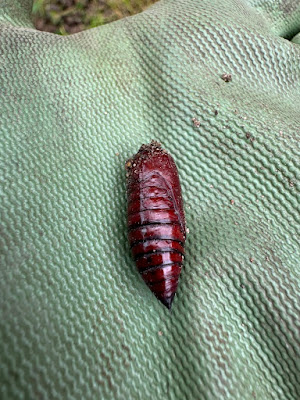One of my lively and delightful tribe of great-nieces (and a nephew) has been in hospital, poor mite, but on the cheery side she's taken a great interest in the arts, crafts and play ideas which they have on the ward and in the garden. She's only four but already a great observer of nature including moths, and she's just done this brilliant exercise in the fascinating subject of their camouflage.
I've quite frequently discussed this here, with examples such as the Buff-tip so resembling a twig and the glorious Merveille du Jour almost invisible on lichen. Here are some of the little one's rather bolder efforts. Don't they make the point well!
Her work must have triggered my own moth antenna and led to that excellent happening, the discovery of a moth here which has never visited before. After disturbing my first Green Carpet of the year while walking along the canal towpath, I noticed a tiny flutter out of the corner of my eye when I was riddling and sprinkling compost in our veg garden.
It was so fragile and low-powered that I thought at first that it was a fragment of leaf disturbed by my shovelling, but once it landed on the soil, it had a definite, triangular moth shape.
Because of its size, the acute, isosoles type of triangle and the longish palps or mouth-parts, I made a second assumption; that it must be a micro-moth. But after consulting both the Micro Bible and the main Moth Bible, I am pretty sure that it is a Buttoned Snout. I often get the ordinary Snout Mouth here, the Pinocchio moth with its very long 'nose' - actually the palps; but its various, smaller relatives are much less common. The Buttoned Snout for example was until recently categorised as 'Nationally Scarce, List B', the third-highest protection level for a species.
That has recently changed thanks to better record-keeping to 'Locally Common' in parts of the South and East of England, including low-lying areas near to the River Thames, which include us. But it's new for my records and very welcome, as are the next two moths.
They are the first hawk moths to visit me in 2024, just a day later than the record debut which was on 26 April during the sunny 'Pandemic Spring'. They are Poplar Hawks, always the first of my seven regular hawk species to arrive. Interestingly, because these are Spring hatching moths unlike the Buttoned Snout which hibernates after emerging in late Summer or Autumn, one of them is already very worn and torn. Life isn't easy for moths.
One of my other Summer pleasures has just started after weeks of Red and even Black Flag conditions on the swollen Thames. I'm out again in Clementine, the doughty touring sculling boat which took me from Oxford to London six years ago on a money-raising sponsored row. Friends in the last three days include this cormorant with its terrific wings-extended stance (drying out the feathers which are not oily like ducks') and lively families of ducklings and goslings. What an excellent time of the year it is, if only it would warm up.












No comments:
Post a Comment